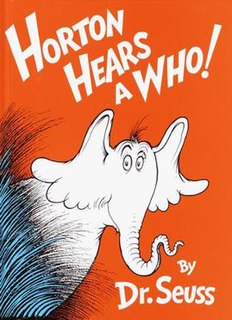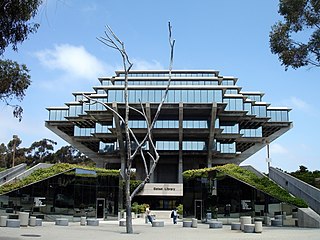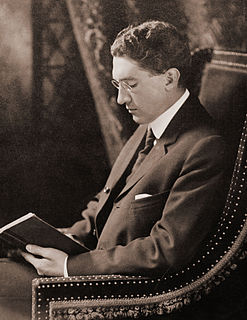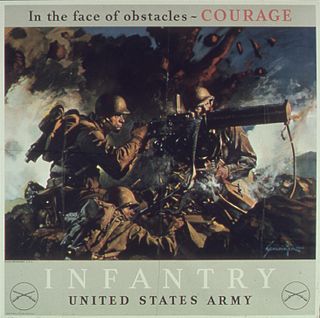Related Research Articles

Theodor Seuss Geisel was an American children's author and cartoonist. He is known for his work writing and illustrating more than 60 books under the pen name Dr. Seuss (,). His work includes many of the most popular children's books of all time, selling over 600 million copies and being translated into more than 20 languages by the time of his death.

The Cat in the Hat is a 1957 children's book written and illustrated by the American author Theodor Geisel, using the pen name Dr. Seuss. The story centers on a tall anthropomorphic cat who wears a red and white-striped top hat and a red bow tie. The Cat shows up at the house of Sally and her brother one rainy day when their mother is away. Despite the repeated objections of the children's fish, the Cat shows the children a few of his tricks in an attempt to entertain them. In the process, he and his companions, Thing One and Thing Two, wreck the house. As the children and the fish become more alarmed, the Cat produces a machine that he uses to clean everything up and disappears just before the children's mother comes home.

Horton Hears a Who! is a children's book written and illustrated by Theodor Seuss Geisel under the pen name Dr. Seuss. It was published in 1954 by Random House. This book tells the story of Horton the Elephant and his adventures saving Whoville, a tiny planet located on a speck of dust, from the animals who mock him. These animals attempt to steal and burn the speck of dust, so Horton goes to great lengths to save Whoville from being incinerated.

Horton Hatches the Egg is a children's book written and illustrated by Theodor Geisel under the pen name Dr. Seuss and published in 1940 by Random House. The book tells the story of Horton the Elephant, who is tricked into sitting on a bird's egg while its mother, Mayzie, takes a permanent vacation to Palm Beach. Horton endures a number of hardships but persists, often stating, "I meant what I said, and I said what I meant. An elephant's faithful, one hundred percent!" Ultimately, the egg hatches, revealing an elephant-bird, a creature with a blend of Mayzie's and Horton's features.

And to Think That I Saw It on Mulberry Street is Theodor Seuss Geisel's first children's book published under the pen name Dr. Seuss. First published by Vanguard Press in 1937, the story follows a boy named Marco, who describes a parade of imaginary people and vehicles traveling along a road, Mulberry Street, in an elaborate fantasy story he dreams up to tell his father at the end of his walk. However, when he arrives home, he decides instead to tell his father what he actually saw—a simple horse and wagon.

Yertle the Turtle and Other Stories is a picture book collection by Theodor Seuss Geisel, published under his more commonly known pseudonym of Dr. Seuss. It was first released by Random House Books on April 12, 1958, and is written in Seuss's trademark style, using a type of meter called anapestic tetrameter. Though it contains three short stories, it is mostly known for its first story, "Yertle the Turtle", in which the eponymous Yertle, king of the pond, stands on his subjects in an attempt to reach higher than the Moon—until the bottom turtle burps and he falls into the mud, ending his rule.
PM was a liberal-leaning daily newspaper published in New York City by Ralph Ingersoll from June 1940 to June 1948 and financed by Chicago millionaire Marshall Field III.

Mo Willems is an American writer, animator, voice actor, and children's book author. His work includes creating the animated television series Sheep in the Big City for Cartoon Network, working on Sesame Street and The Off-Beats, and creating the popular children's book series Elephant and Piggie.

Mischa Richter was an American cartoonist best known for his numerous cartoons published in The New Yorker over decades.

The Secret Art of Dr. Seuss (ISBN 0-679-43448-8) is a collection of visual art created by Theodor Seuss Geisel, better known as Dr. Seuss. It was published in 1995, after Geisel's death, by Random House of New York.

Geisel Library is the main library building of the University of California, San Diego. It is named in honor of Audrey and Theodor Seuss Geisel. Theodor is better known as children's author Dr. Seuss. The building's distinctive architecture, described as occupying "a fascinating nexus between brutalism and futurism", has resulted in its being featured in the UC San Diego logo and becoming the most recognizable building on campus.

John Haynes Holmes was a prominent Unitarian minister, pacifist, and co-founder of the NAACP and the ACLU. He is noted for his anti-war activism.

During active American involvement in World War II (1941–45), propaganda was used to increase support for the war and commitment to an Allied victory. Using a vast array of media, propagandists instigated hatred for the enemy and support for America's allies, urged greater public effort for war production and victory gardens, persuaded people to save some of their material so that more material could be used for the war effort, and sold war bonds. Patriotism became the central theme of advertising throughout the war, as large scale campaigns were launched to sell war bonds, promote efficiency in factories, reduce ugly rumors, and maintain civilian morale. The war consolidated the advertising industry's role in American society, deflecting earlier criticism. The axis leaders were portrayed as cartoon caricatures to make them appear foolish and idiotic.
Helen Marion Palmer Geisel, known professionally as Helen Palmer, was an American children's writer, editor, and philanthropist. She was also the Founder and Vice President of Beginner Books, and was married to fellow writer Theodor Seuss Geisel, better known as Dr. Seuss, from 1927 until her death.
Richard H. Minear is a retired Professor of History at the University of Massachusetts Amherst. He taught a survey course of Japanese history and a Hiroshima seminar. Minear got his Ph.D. from Harvard in 1968. He is best known for his book about the Tokyo War Crimes Trials, Victors' Justice, He has lived in Japan for many years and translated Japanese works into English.
Design for Death is a 1947 American documentary film that won the Academy Award for Best Documentary Feature. It was based on a shorter U.S. Army training film, Our Job in Japan, that had been produced in 1945–1946 for the soldiers occupying Japan after World War II. Both films dealt with Japanese culture and the origins of the war.
Theodor Seuss Geisel, better known as Dr. Seuss, published over 60 children's books over the course of his long career. Though most were published under his well-known pseudonym, Dr. Seuss, he also authored over a dozen books as Theo. LeSieg and one as Rosetta Stone.
Donald E. Pease is the Ted and Helen Geisel Third Century Professor in the Humanities, chair of the Master of Arts in Liberal Studies Program, professor of English and comparative literature at Dartmouth College. He is an Americanist, literary and cultural critic, and academic. He has been a member of the boundary 2 editorial collective since 1977 or 1978. He was the founding editor of the New Americanist Series at Duke University Press and editor of the Re-Encountering Colonialism Series and Re-Mapping the Transnational Turn: A Dartmouth Series in American Studies for the University Press of New England (UPNE). Pease directs the annual Futures of American Studies Institute at Dartmouth.
The political messages of Theodor Seuss Geisel, best known as Dr. Seuss, are found in many of his books. Geisel, a cartoonist and author for children, was also a liberal and a moralist who expressed his views in his books through the use of ridicule, satire, wordplay, nonsense words, and wild drawings to take aim at bullies, hypocrites, and demagogues.

Horse Museum is a Dr. Seuss book released by Random House Children's Books on September 3, 2019. It is based on an unfinished manuscript by Theodor Seuss Geisel completed by Australian illustrator Andrew Joyner. 250,000 copies were released of the first printing.
References
- ↑ Beth Gardiner, "Little-Known Seuss Political Cartons Mixed Whimsy, War", Associated Press in The Columbian , August 31, 1999 – via HighBeam Research (subscription required).
- ↑ Minear, Richard H. (1999). Dr. Seuss Goes to War: The World War II Editorial Cartoons of Theodor Seuss Geisel . New York, New York: The New Press. p. 9. ISBN 1-56584-565-X.
- ↑ Dr. Seuss (w, a). "Waiting for the Signal from Home" PM(February 13, 1942), retrieved on September 24, 2012
- ↑ "Dr. Seuss Went to War - Redirect". Archived from the original on 2012-05-12. Retrieved 2012-09-24.
- ↑ "Republican Party List". Archived from the original on 2012-05-12. Retrieved 2012-09-24.
- ↑ Minear (1999), p. 191.
- ↑ Peggy Constantine, " Horton Saves the World", The New York Times , January 9, 2000.
- ↑ Our war load Archived 2012-04-17 at the Wayback Machine , from "Dr. Seuss Went to War: A Collection of Political Cartoons" at UC San Diego Library Special Collections.
- ↑ Gnawing at our life line Archived 2012-04-17 at the Wayback Machine , from "Dr. Seuss Went to War: A Collection of Political Cartoons" at UC San Diego Library Special Collections.
- ↑ Minear (1999), p. 190–1.
- ↑ "Dr. Seuss Goes to War: The World War II Editorial Cartoons Of Theodor Seuss Geisel (review)". Entertainment Weekly . November 5, 1999. Retrieved August 16, 2022.
- ↑ "Picks and Pans Review: Dr. Seuss Goes to War", 'People , November 15, 1999.
- ↑ Gaby Wood, "Seuss's other hat: In Dr Seuss Goes to War, Richard Minear shows how Dr Seuss's wartime cartoons of Hitler reveal the darker side of the creator of the Cat in the Hat", The Guardian , August 5, 2000.
- ↑ Ray Cormier, "Travel Advisory; Museum Shows Off Dr. Seuss' Serious Side", The New York Times, July 30, 2000.
- ↑ Douglas Britt, "Idea behind Dr. Seuss show is better than its execution", Houston Chronicle , July 2, 2009.
- ↑ André Schiffrin, "Combative Cartoons", Los Angeles Times , September 27, 2009.